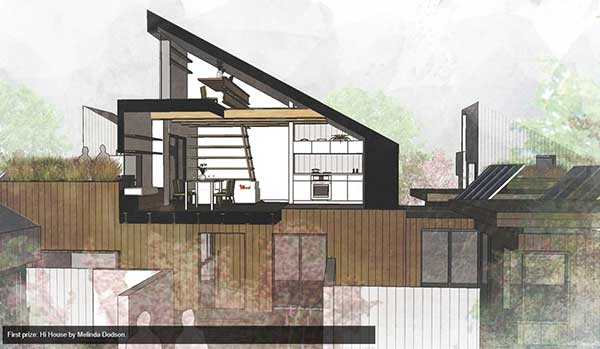Mar 2016
This month
- High-risk building products
- Ministerial Changes
- Universal Access
- Value of good design recognised by Infrastructure Australia
- Designer Terminology
- AILA living cities alliance
- Procurement
- City of South Perth Amendment No. 46
- Greater Sydney Commission
- Planning Reform
High-risk building products
The Building Ministers’ Forum recently met at the Gold Coast and agreed to work cooperatively to implement a range of measures to address safety issues associated with high-risk building products. This work is to be undertaken by the Australian Building Codes Board (ABCB), and will support measures to address the risks specifically associated with cladding used in high rise buildings. This followed on from the release of a report by the Victoria Building Authority (VBA), which found widespread use of non-compliant fire-prone cladding in high-rise apartment buildings. The audit found that 51 percent of the 170 buildings had external wall cladding that was non-compliant.
The ABCB is considering measures such as mandatory third party accredited certification of cladding materials, and looking at a new verification method referencing a new Australian standard for determining the fire combustibility of wall claddings and wall assemblies.
Other than Victoria, and the Western Australian government’s audit of Perth buildings, no other state or territory has undertaken an audit. The VBA has issued an industry alert on external walls and BCA compliance, which can be accessed from www.vba.vic.au
Ministerial Changes
The Christmas period saw the resignation of Jamie Briggs, the Minister for Cities and the Built Environment. The portfolio was transferred on a temporary basis to the Minister for the Environment, Greg Hunt. The Prime Minister announced a reshuffle of Ministers on Saturday 13 February. There is no longer a Minister for Cities. Instead, Angus Taylor has been given the role as Assistant Minister to the Prime Minister with special responsibility for Cities and Digital Transformation. We are seeking a meeting with the new Assistant Minister to put forward our views on Creating Australia’s towns & cities of the future
Universal Access
The Hon Susan Ryan AO, Age and Disability Discrimination Commissioner with the Australian Human Rights Commission requested a meeting with representatives of the AIA to talk about universal access issues. The briefing was held at 2a Mugga Way, Canberra and was attended by ACT President, Andrew Wilson, Eric Martin, Convenor of the National Access Work Group, Murray Coleman, a local expert on access, and Leanne Hardwicke, ACT Chapter Manager and National Policy Advisor. The discussion was wide-ranging but focussed on ways in which industry could be better engaged and ways to increase the stock of accessible homes, not only for the disabled but also for the aged. It was agreed that the Institute would assist with providing technical information and access to experts, and to assist in bringing together an industry forum on the issue.
Value of Good Design Recognised by Infrastructure Australia
Infrastructure Australia has released the Australian Infrastructure Plan, which makes a raft of recommendations that will help the country to accommodate a population of 30 million by 2031.
The report contains 78 recommendations, addressing issues including high-density development in established areas, a potential national user-pays system for roads and data-driven approaches to managing transport and other infrastructure systems. It also proposes encouraging more population growth in smaller cities such as Hobart and Adelaide and compulsory Building Information Modelling on large-scale infrastructure projects.
The Australia Infrastructure Plan recommends that cities such as Melbourne, Sydney, Brisbane and Perth should ensure that most new housing supply is medium to high-density and built in established areas. The report suggests that this could be achieved on a local and state/territory level by incentivising good design and aligning high-density projects with other infrastructure upgrades. In support of good design, the report offers the following:
“Governments should also support the development of well-designed and affordable housing. State, territory and local governments should explore options to encourage good outcomes through incentives in the planning approval process. For example, increased floor space could be offered as an incentive for developers who: Partner with an architect with proven credentials for delivering high-quality, high-density developments; Increase the provision of private open space in their development proposal; or Include an affordable housing component on site or as a financial contribution.”
The report can be accessed through this link.
Designer terminology (Tas)
Tasmanian architects have expressed ongoing concern about the use of the terms “architectural,” “architect” and related derivatives, particularly in relation to non-architect designers. The Department of Justice in Tasmania currently uses the terms “Architectural Restricted,” “Architectural Limited” and “Architectural Domestic” on its website to describe the accreditation of building designers. The Tasmanian Chapter of the Institute believes this creates confusion in the community, increasing the risk that consumers may mistakenly assume the skills and competencies of building designers are equivalent to architects. The Board of Architects in Tasmania has received legal advice that these terms should be restricted to persons registered under the Architects Act. As a result of this, the Tasmanian Chapter is having discussions with the Department of Justice to push for the appropriate amendments, in order to remove any consumer confusion.
AILA living cities alliance
Ministers of the Australian Government in conjunction with key industry organisations, including AILA and the Institute, announced the new Living Cities Alliance at the Parliament House in February.
A workshop featuring a range of industry representatives developed an Action Plan and Report to be submitted to the Minister to inform in advance, the Government’s Cities Policy Forum Position Paper and Summit being released early this year. The report will outline the economic, health and environmental benefits of various innovative, greener city initiatives that could be implemented in Australia’s urban centres.
Procurement (Tas)
Procurement practices have long been a source of frustration for architects. The Tasmanian Government has reviewed its procurement guidelines in its Procurement Practices Manual – Best Practice for the Engagement of Consultants. The Tasmanian Chapter of the Institute supports clear guidelines around the engagement of consultants to help achieve the best outcomes for everyone and minimise confusion about the process. As such, the Tasmanian Chapter has offered its qualified support for the revised manual and encouraged its implementation across all government departments and agencies.
City of South Perth Amendment No. 46 (WA)
The WA Chapter opposed the amendment, believing it to be retrograde and contrary to the spirit of the State Government’s Directions 2031 and Beyond planning strategy that recommends high-quality inner-city development to meet population growth. Of particular concern is the proposed removal of up to 15% (or 20,000m2 ) of developable land, something that threatens more than $240 million in direct construction investment and an estimated 8000 jobs. Similarly, the proposed height limit reductions, commercial-residential ratios and setbacks represent a significant impediment to investment.
Greater Sydney Commission (NSW)
Late last year the NSW Government announced the first appointments to this new organisation responsible for the orderly development of the Sydney region: Lucy Turnbull (Chair), Sarah Hill (Chief Executive) and three Commissioners. The Chapter was delighted that Institute member Rod Simpson was appointed Environment Commissioner. We are also pleased that former NSW President Deborah Dearing has been appointed District Commissioner for the northern region.
The Chapter is an enthusiastic supporter of the Commission concept; it accords with our recommendations through the planning reform process in recent years. However, there is nothing in the documentation we have seen to date that addresses the critical question of design quality. We have written to the responsible Department and Commissioners recommending a number of improvements, particularly the active involvement of the Government Architect’s Office.
Planning reform (NSW)
The Institute was a founding member (with PIA, the Property Council and the Sydney Business Chamber) of the Coalition for NSW Planning Reform, a group of professional, property and business groups. Formed in August 2007, we gained government support for several substantial planning system improvements, such as the delegation of major project assessments to the Planning Assessment Commission and the creation of the Housing Code and Joint Regional Planning Panels.
In February, NSW Chapter President Shaun Carter was part of a delegation that met with Planning Minister Rob Stokes to urge the Baird Government to adopt some significant initiatives that would improve the functioning of the planning system under the current legislation, while also providing stepping stones towards a more comprehensive overhaul through new legislation at a later date.
The Minister was receptive to the proposals. The Chapter is confident that with further consistent lobbying, both as an individual organisation and as a member of the coalition, these necessary improvements to the current complex planning system will be achieved.





 The New Year is associated with resolutions – to learn new skills, improve in some manner, conquer weaknesses….One common resolution is to become more healthy and many a gym membership has been entered into on the basis of such New Year fervour.
The New Year is associated with resolutions – to learn new skills, improve in some manner, conquer weaknesses….One common resolution is to become more healthy and many a gym membership has been entered into on the basis of such New Year fervour.